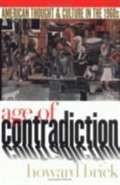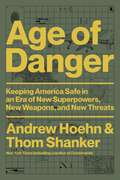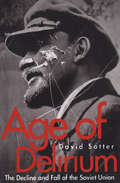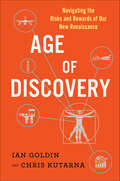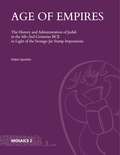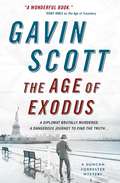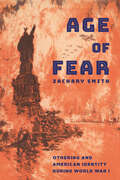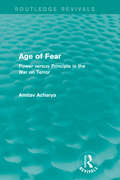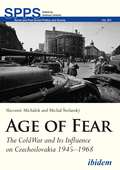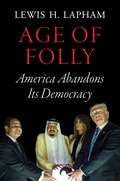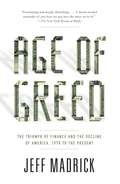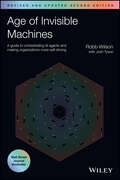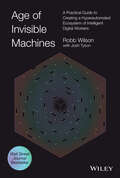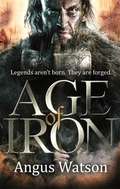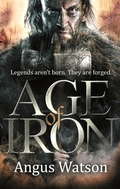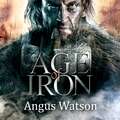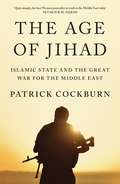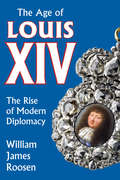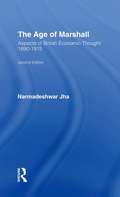- Table View
- List View
Age of Contradiction: American Thought and Culture in the 1960s
by Howard BrickIn Age of Contradiction, Howard Brick provides a rich context for understanding historical events, cultural tensions, political figures, artistic works, and trends of intellectual life. His lucid and comprehensive book combines the best methods of historical analysis and assessment with fascinating subject matter to create a three-dimensional portrait of a complicated time. In one of the only books on the 1960s to put ideas at the center of the period's history, Brick carefully explores the dilemmas, the promise, and the legacy of American thought in that time.
Age of Crowns: Pursuing Lives Marked by the Kingdom of God
by Kori de LeonYou were made for more than this life has to offer. That&’s why you never feel quite satisfied. Even when you feel happiest, discontent is always looming at the door. That&’s because God created you for something far greater than this life; He created you for Jesus Christ and His Kingdom.In Age of Crowns, Kori de Leon will awaken the dreamer in you as she invites you to explore glorious images of the Age to Come. Whether we realize it or not, God designed us for a:KING-to be loved and led by an excellent kingCROWN-to reflect dignity and worth as image-bearersKINGDOM-to have a purpose bigger than ourselves CASTLE-to find a secure sense of home This book is an inspiring examination of how the future hope of heaven changes your today. It will teach you how to faithfully await (and prepare for) the Age to Come, as well as how to live a more purposeful and fulfilling life with Christ here and now.
Age of Crowns: Pursuing Lives Marked by the Kingdom of God
by Kori de LeonYou were made for more than this life has to offer. That&’s why you never feel quite satisfied. Even when you feel happiest, discontent is always looming at the door. That&’s because God created you for something far greater than this life; He created you for Jesus Christ and His Kingdom.In Age of Crowns, Kori de Leon will awaken the dreamer in you as she invites you to explore glorious images of the Age to Come. Whether we realize it or not, God designed us for a:KING-to be loved and led by an excellent kingCROWN-to reflect dignity and worth as image-bearersKINGDOM-to have a purpose bigger than ourselves CASTLE-to find a secure sense of home This book is an inspiring examination of how the future hope of heaven changes your today. It will teach you how to faithfully await (and prepare for) the Age to Come, as well as how to live a more purposeful and fulfilling life with Christ here and now.
Age of Danger: Keeping America Safe in an Era of New Superpowers, New Weapons, and New Threats
by Andrew Hoehn Thom ShankerAn urgent look at how America's national security machine went astray and how it fails to keep us safe—and what we can do to fix it. Again and again, American taxpayers are asked to open their wallets and pay for a national security machine that costs $1 trillion operate. Yet time and time again, the US government gets it wrong on critical issues. So what can be done? Enter bestselling author Thom Shanker and defense expert Andrew Hoehn. With decades of national security expertise between them and access to virtually every expert, they look at what&’s going wrong in national security and how to make it go right. Age of Danger looks at the major challenges facing America—from superpowers like Russia and China to emerging threats like pandemics, cybersecurity, climate change, and drones—and reimagines the national security apparatus into something that can truly keep Americans safe. Weaving together expert analysis with exclusive interviews from a new generation of national security leaders, Shanker and Hoehn argue that the United States must create an industrial-grade, life-saving machine out of a system that, for too long, was focused only on deterring adversaries and carrying out global military operations. It is a timely and crucial call to action—a call that if heeded, could save Americans lives, money, and our very future on the global stage.
Age of Delirium: The Decline and Fall of the Soviet Union
by David SatterThe first state in history to be based explicitly on atheism, the Soviet Union endowed itself with the attributes of God. In this book, David Satter shows through individual stories what it meant to construct an entire state on the basis of a false idea, how people were forced to act out this fictitious reality, and the tragic human cost of the Soviet attempt to remake reality by force.“I had almost given up hope that any American could depict the true face of Russia and Soviet rule. In David Satter’s Age of Delirium, the world has received a chronicle of the calvary of the Russian people under communism that will last for generations.†?—Vladimir Voinovich, author of The Life and Extraordinary Adventures of Private Ivan Chonkin“Spellbinding. . . . Gives one a visceral feel for what it was like to be trapped by the communist system.†?—Jack Matlock, Washington Post“Satter deserves our gratitude. . . . He is an astute observer of people, with an eye for essential detail and for human behavior in a universe wholly different from his own experience in America.†?—Walter Laqueur, Wall Street Journal “Every page of this splendid and eloquent and impassioned book reflects an extraordinarily acute understanding of the Soviet system.†?—Jacob Heilbrunn, Washington Times
Age of Discovery: Navigating the Risks and Rewards of Our New Renaissance
by Ian Goldin Chris KutarnaThe present is a contest between the bright and dark sides of discovery. To avoid being torn apart by its stresses, we need to recognize the fact—and gain courage and wisdom from the past. Age of Discovery shows how.Now is the best moment in history to be alive, but we have never felt more anxious or divided. Human health, aggregate wealth and education are flourishing. Scientific discovery is racing forward. But the same global flows of trade, capital, people and ideas that make gains possible for some people deliver big losses to others—and make us all more vulnerable to one another. Business and science are working giant revolutions upon our societies, but our politics and institutions evolve at a much slower pace. That’s why, in a moment when everyone ought to be celebrating giant global gains, many of us are righteously angry at being left out and stressed about where we’re headed.To make sense of present shocks, we need to step back and recognize: we’ve been here before. The first Renaissance, the time of Columbus, Copernicus, Gutenberg and others, likewise redrew all maps of the world, democratized communication and sparked a flourishing of creative achievement. But their world also grappled with the same dark side of rapid change: social division, political extremism, insecurity, pandemics and other unintended consequences of discovery.Now is the second Renaissance. We can still flourish—if we learn from the first.
Age of Empires: The History and Administration of Judah in the 8th–2nd Centuries BCE in Light of the Storage-Jar Stamp Impressions (Mosaics: Studies on Ancient Israel #2)
by Oded LipschitsStorage jars of many shapes and sizes were in widespread use in the ancient world, transporting and storing agricultural products such as wine and oil, crucial to agriculture, economy, trade and subsistence. From the late 8th to the 2nd century BCE, the oval storage jars typical of Judah were often stamped or otherwise marked: in the late 8th and early 7th century BCE with lmlk stamp impressions, later in the 7th century with concentric circle incisions or rosette stamp impressions, in the 6th century, after the fall of Jerusalem, with lion stamp impressions, and in the Persian, Ptolemaic and Seleucid periods (late 6th–late 2nd centuries BCE) with yhwd stamp impressions. At the same time, several ad hoc systems of stamp impressions appeared: "private" stamp impressions were used on the eve of Sennacherib’s campaign, mwṣh stamp impressions after the destruction of Jerusalem, and yršlm impressions after the establishment of the Hasmonean state. While administrative systems that stamped storage jars are known elsewhere in the ancient Near East, the phenomenon in Judah is unparalleled in its scale, variety and continuity, spanning a period of some 600 years without interruption.This is the first attempt to consider the phenomenon as a whole and to develop a unified theory that would explain the function of these stamp impressions and shed new light on the history of Judah during six centuries of subjugation to the empires that ruled the region—as a vassal kingdom in the age of the Assyrian, Egyptian, and Babylonian empires and as a province under successive Babylonian, Persian, Ptolemaic, and Seleucid rule.
Age of Entanglement
by Kris Manjapra"Age of Entanglement "explores patterns of connection linking German and Indian intellectuals from the nineteenth century to the years after the Second World War. Kris Manjapra traces the intersecting ideas and careers of a diverse collection of individuals from South Asia and Central Europe who shared ideas, formed networks, and studied one another's worlds. Moving beyond well-rehearsed critiques of colonialism towards a new critical approach, this study recasts modern intellectual history in terms of the knotted intellectual itineraries of seeming strangers. Collaborations in the sciences, arts, and humanities produced extraordinary meetings of German and Indian minds. Meghnad Saha met Albert Einstein, Stella Kramrisch brought the Bauhaus to Calcutta, and Girindrasekhar Bose began a correspondence with Sigmund Freud. Rabindranath Tagore traveled to Germany to recruit scholars for a new Indian university, and the actor Himanshu Rai hired director Franz Osten to help establish movie studios in Bombay. These interactions, Manjapra argues, evinced shared responses to the cultural and political hegemony of the British empire. Germans and Indians hoped to find in one another the tools needed to disrupt an Anglocentric world order. As Manjapra demonstrates, transnational intellectual encounters are not inherently progressive. From Orientalism and Aryanism to socialism and scientism, German-Indian entanglements were neither necessarily liberal nor conventionally cosmopolitan, often characterized as much by manipulation as by cooperation. "Age of Entanglement "underscores the connections between German and Indian intellectual history, revealing the characteristics of a global age when the distance separating Europe and Asia seemed, temporarily, to disappear.
Age of Exodus, The (Duncan Forrester Mystery #3)
by Gavin ScottIt's 1947. As Britain's new Labour government struggles to cope with the break-up of Empire, there's a grisly murder in the British Museum, terrorists target British Foreign Secretary Ernest Bevin and Forrester boards the Queen Mary for a fateful voyage to New York.
Age of Fear: Othering and American Identity during World War I
by Zachary SmithFear can be more dangerous than the threats we think loom over us—how Germans and German Americans were perceived as a dangerous enemy during World War I.Although Americans have long celebrated their nation's diversity, they also have consistently harbored suspicions of foreign peoples both at home and abroad. In Age of Fear, Zachary Smith argues that, as World War I grew more menacing and the presumed German threat loomed over the United States, many white "Anglo-Saxon" Americans grew increasingly concerned about the vulnerability of their race, culture, and authority. Consequently, they directed their long-held apprehensions over ethnic and racial pluralism onto their German neighbors and overseas enemies whom they had once greatly admired.Smith examines the often racially tinged, apocalyptic arguments made during the war by politicians, propaganda agencies, the press, novelists, and artists. He also assesses citizens' reactions to these messages and explains how the rise of nationalism in the United States and Europe acted as a catalyst to hierarchical racism. Germans in both the United States and Europe eventually took the form of the proverbial "Other," a dangerous, volatile, and uncivilized people who posed an existential threat to the nation and all that Anglo-Saxon Americans believed themselves to be. Exploring what the Great War meant to a large portion of the white American population while providing a historic precedent for modern-day conceptions of presumably dangerous foreign Others, Age of Fear is a compelling look at how the source of wartime paranoia can be found in deep-seated understandings of racial and millennial progress.
Age of Fear: Power Versus Principle in the War on Terror (Routledge Revivals)
by Amitav AcharyaFirst published in 2004 in the immediate wake of the September 11 terrorist attacks, this is an accessible commentary intended to provoke thought and debate on the topic of terrorism. In a collection of challenging essays, questions consider the causes of terrorism and why post-modern terrorism is different. The essays are divided into three key sections, first investigating the civilizational roots and dimensions of contemporary terrorism, next examining the Bush administration’s approach, and finally, considering the complex and changing relationship between fear and freedom. Written by a leading scholar in Middle East and Asian Studies, this comprehensive reissue will be of particular value to students of international relations and terrorism studies, as well as the more general reader with an interest in the global issues faced in the age of contemporary terrorism.
Age of Fear: The Cold War and Its Influence on Czechoslovakia, 1945–1968 (Soviet and Post-Soviet Politics and Society #201)
by Slavomír Michálek Michal ŠtefanskýCzechoslovakia played an important role within the Soviet bloc, yet its history remains underresearched. This monograph blends historical analysis of the superpowers’ foreign policies with an assessment of their impact on Czechoslovakia and its position within the Soviet bloc. The book thereby places Czechoslovakia on the map of Cold War history, i.e. the era of “mutually assured destruction” that lasted almost half a century. <P><P> It provides a lucid introduction to some milestones in international Cold War history in their relation to Czecho-Slovak history. The book’s novel contribution is to explain Czechoslovakia’s domestic situation during the Cold War from the “outside.” Drawing on extensive source materials of Slovak, Czech, American, and Russian provenance, it provides a more comprehensive understanding of postwar Czecho-Slovak history while also contributing to general knowledge about the nature and impact of the Cold War.
Age of Folly: America Abandons Its Democracy
by Lewis H. LaphamAmerica's leading essayist on the frantic retreat of democracy, in the fire and smoke of the war on terrorIn twenty-five years of imperial adventure, America has laid waste to its principles of democracy. The self-glorifying march of folly steps off at the end of the Cold War, in an era when delusions of omnipotence allowed the market to climb to virtual heights, while society was divided between the selfish and frightened rich and the increasingly debt-ridden and angry poor. The new millennium saw the democratic election of an American president nullified by the Supreme Court, and the pretender launching a wasteful, vainglorious and never-ending war on terror, doomed to end in defeat and the loss of America's prestige abroad.All this culminates in the sunset swamp of the 2016 election--a farce dominated by Donald Trump, a self-glorifying photo-op bursting star-spangled bombast in air. This spectacle would be familiar to Aristotle, whose portrayal of the "prosperous fool" describes a class of people who "consider themselves worthy to hold public office, for they already have the things that give them a claim to office."From the Hardcover edition.
Age of Greed: The Triumph of Finance and the Decline of America, 1970 to the Present
by Jeff MadrickA vividly told history of how greed bred America's economic ills over the last forty years, and of the men most responsible for them.As Jeff Madrick makes clear in a narrative at once sweeping, fast-paced, and incisive, the single-minded pursuit of huge personal wealth has been on the rise in the United States since the 1970s, led by a few individuals who have argued that self-interest guides society more effectively than community concerns. These stewards of American capitalism have insisted on the central and essential place of accumulated wealth through the booms, busts, and recessions of the last half century, giving rise to our current woes.In telling the stories of these politicians, economists, and financiers who declared a moral battle for freedom but instead gave rise to an age of greed, Madrick traces the lineage of some of our nation's most pressing economic problems. He begins with Walter Wriston, head of what would become Citicorp, who led the battle against government regulation. He examines the ideas of economist Milton Friedman, who created the plan for an anti-Rooseveltian America; the politically expedient decisions of Richard Nixon that fueled inflation; the philosophy of Alan Greenspan, on whose libertarian ideology a house of cards was built on Wall Street; and the actions of Sandy Weill, who constructed the largest financial institution in the world, which would have gone bankrupt in 2008 without a federal bailout of $45 billion. Significant figures including Ivan Boesky, Michael Milken, Jack Welch, and Ronald Reagan play key roles as well.Intense economic inequity and instability is the story of our age, and Jeff Madrick tells it with style, clarity, and an unerring command of his subject.From the Hardcover edition.
Age of Icons
by Martijn Konings Gavin FridellCelebrities are increasingly front and centre in public debates on everything from solving world poverty to halting genocide, confronting obesity, and finding spiritual contentment. Bono, Bill Gates, Al Gore, Bob Geldof, Oprah, Madonna, and Angelina Jolie are just some of the entertainers, politicians, pundits, elite business people, and policy-makers whose highly visible political activism has become an integral part of their public personas.These pop icons tend to be celebrated as "philanthrocapitalists" with a unique ability to remedy the world's problems. However, as Age of Icons demonstrates, the solutions these icons promote for addressing global injustice, when examined critically, can be seen to work through the very same institutions that create these problems in the first place.This volume assesses the growing role of popular icons in the construction of a culture that appears to incorporate a critical attitude towards the capitalist experience while, in fact, legitimizing the neoliberal character of the modern world. It will be an eye-opening read for anyone interested in the juncture between current events and celebrity culture.
Age of Invisible Machines: A Guide to Orchestrating AI Agents and Making Organizations More Self-Driving, Revised and Updated
by Robb Wilson Josh TysonCut through the noise and unlock the transformational power of conversational AI In the newly revised second edition of Age of Invisible Machines, renowned tech leader Robb Wilson delivers a startlingly insightful and eye-opening blueprint for using conversational AI to make your company self-driving—with a digital ecosystem of interconnected automations powering all aspects of your business. Conversational AI is transforming every job at every company (starting yesterday) and this book is perfect for anyone affected by these technologies. You'll learn how to develop a hyperautomation strategy by identifying outdated processes and systems holding your company back. This latest edition offers brand new chapters dedicated to fast-growing automation tools, including Large Language Models, generative AI, and much more. You'll discover ways to implement new technologies that are force-multipliers for rapid growth. A must-read for every business leader, Wilson's book debunks common myths about conversational AI while simplifying the inevitable complexity of restructuring your business to unlock the substantial opportunities this new era offers. You'll also find: Incisive discussions of the ethical dilemmas that lie before us as mass adoption of conversational AI takes effect Fascinating examinations of what a self-driving business looks like and how you can use conversational AI to generate an enduring competitive advantage Strategies for creating a hyperautomated ecosystem that any company can begin using immediately QR links to interactive and ongoing discussions of the subjects covered in each chapter A practical and essential exploration of the future of conversational AI and hyperautomation, Age of Invisible Machines belongs in the hands of entrepreneurs, founders, business leaders, tech enthusiasts, designers and anyone else with a stake in the future of business.
Age of Invisible Machines: A Practical Guide to Creating a Hyperautomated Ecosystem of Intelligent Digital Workers
by Robb WilsonCut through the hype and unlock the game-changing potential of conversational AI. In Age of Invisible Machines, celebrated tech leader Robb Wilson delivers an eye-opening and startlingly insightful blueprint for leveraging conversational AI in order to make your organization self-driving—with a growing ecosystem of interconnected automations accelerating all aspects of your business. Conversational AI is changing the nature of every job at every company (starting yesterday) and this book is relevant for anyone who will be affected by the acceleration of these technologies. You&’ll learn how to develop a strategy for hyperautomation by identifying the outdated processes and systems holding your organization back. You&’ll discover ways of internalizing and orchestrating new technologies that are force-multipliers for rapid growth. A must-read for every business leader, Wilson&’s book debunks common myths about conversational AI while laying bare the inevitable complexity of restructuring your business to unlock the massive opportunities this new era affords. You&’ll also find: Compelling discussions of the ethical dilemmas that lie in wait as mass adoption of conversational AI takes hold Fascinating explorations of what a self-driving organization looks like and how you can use conversational AI to create a durable competitive advantage Strategies behind creating an ecosystem for hyperautomation that any company can begin implementing immediately QR links to ongoing, interactive online discussions of the material covered in each chapter An essential and practical discussion of the future of conversational AI and hyperautomation, Age of Invisible Machines belongs in the hands of founders, entrepreneurs, business leaders, designers, tech enthusiasts, and anyone else with a stake in the future of business.
Age of Iron (Iron Age #1)
by Angus WatsonLEGENDS AREN'T BORN. THEY'RE MADE.Dug Sealskinner is a down-on-his-luck mercenary traveling south to join up with King Zadar's army. But he keeps rescuing the wrong people.First Spring, a child he finds scavenging on the battlefield, and then Lowa, one of Zadar's most fearsome warriors, who has vowed revenge on the king for her sister's execution.Now Dug's on the wrong side of the thousands-strong army he hoped to join -- and worse, Zadar has bloodthirsty druid magic on his side. All Dug has is his war hammer, one small child, and one unpredictable, highly-trained warrior with a lust for revenge that might get them all killed . . .
Age of Iron (The Iron Age Trilogy #1)
by Angus WatsonLEGENDS AREN'T BORN. THEY'RE FORGED.Dug Sealskinner is a down-on-his-luck mercenary travelling south to join up with King Zadar's army. But he keeps rescuing the wrong people. First, Spring, a child he finds scavenging on the battlefield, and then Lowa, one of Zadar's most fearsome warriors, who's vowed revenge on the king for her sister's execution. Now Dug's on the wrong side of that thousands-strong army he hoped to join - and worse, Zadar has bloodthirsty druid magic on his side. All Dug has is his war hammer, one rescued child and one unpredictable, highly-trained warrior with a lust for revenge that's going to get them all killed . . . It's a glorious day to die.Look out now for YOU DIE WHEN YOU DIE - first in a new historical fantasy series from Angus Watson.'Watson's tale is gore soaked and profanity laden - full of visceral combat and earthy humor, and laced with subtle magic. The blend of historical accuracy and authorial liberties suggests an old-school sword-and-sorcery epic, though with some modern sensibilities thrown in for good measure!' PUBLISHERS WEEKLY'Would I read the next one? Yes, absolutely. Bring me my hammer, bring my beer, bring it on.' SF CROWSNEST'Watson has created a brilliant and confident debut . . . If you like your fantasy packed with hammer-wielding heroes, bloodthirsty druids, strong female leads, action, intrigue, betrayal, and a brilliantly conceived world then AGE OF IRON is for you.' THE BOOK BEARD'Thoroughly entertaining from the get go . . . I really got a kick out of the AGE OF IRON'THE ELOQUENT PAGEFor more epic action from Angus Watson, check out:West of West TrilogyYou Die When You DieThe Land you Never LeaveWhere Gods Fear to GoThe Iron Age TrilogyAge of IronClash of IronReign of Iron
Age of Iron (The Iron Age Trilogy)
by Angus WatsonLEGENDS AREN'T BORN. THEY'RE MADE. Dug Sealskinner is a down-on-his-luck mercenary travelling south to join up with King Zadar's army. But he keeps rescuing the wrong people. First, Spring, a child he finds scavenging on the battlefield, and then Lowa, one of Zadar's most fearsome warriors, who's vowed revenge on the king for her sister's execution. Now Dug's on the wrong side of that thousands-strong army he hoped to join - and worse, Zadar has bloodthirsty druid magic on his side. All Dug has is his war hammer, one rescued child and one unpredictable, highly-trained warrior with a lust for revenge that's going to get them all killed . . . It's a glorious day to die.
Age of Jihad: Islamic State and the Great War for the Middle East
by Patrick CockburnFrom the award-winning author of The Rise of Islamic State, the essential story of the Middle East's disintegrationThe Age of Jihad charts the turmoil of today's Middle East and the devastating role the West has played in the region from 2001 to the present. Beginning with the US-led invasion of Afghanistan, Cockburn explores the vast geopolitical struggle that is the Sunni-Shia conflict, a clash that shapes the war on terror, western military interventions, the evolution of the insurgency, the civil wars in Yemen, Libya and Syria, the Arab Spring, the fall of regional dictators, and the rise of Islamic State. As Cockburn shows in arresting detail, Islamic State did not explode into existence in Syria in the wake of the Arab Spring, as conventional wisdom would have it. The organization gestated over several years in occupied Iraq, before growing to the point where it can threaten the stability of the whole region. Cockburn was the first Western journalist to warn of the dangers posed by Islamic State. His originality and breadth of vision make The Age of Jihad the most in-depth analysis of the regional crisis in the Middle East to date.From the Hardcover edition.
Age of Louis XIV: The Rise of Modern Diplomacy
by William James RoosenWilliam James Roosen has written the first general study of European diplomacy in the age of Louis XIV which is based on the actual practices and institutions of that era, rather than on the writing of early theoreticians.Though the seventeenth century may not have been a period of great innovations in international diplomacy, it provides us with an important illustration of the "workings of a system which was well suited to the gradually changing needs of its time" and which has been called "the best form of diplomacy ever developed."Dr. Roosen demonstrates both the obvious differences and the many similarities between diplomatic procedures and practices of the seventeenth century and the twentieth. Any student of diplomacy and international relations will gain valuable insight and understanding from this study of the early modern diplomatic personalities, institutions, and practices.One of Dr. Roosen's goals in writing this book has been to discover the relationships between the ideological and socioeconomic structures and the diplomatic personalities who have influenced modern diplomacy. Further, he supplies the only available study of the realities of diplomatic practices in seventeenth century Europe, and provides an excellent basis for comparison with twentieth century international relations, in the hope that "studying early modern diplomatic personalities, institutions and practices should increase our understanding of international relations today."There are chapters on "The States of Europe," "Kings and Ministers," "Ambassadors," "Second Class Diplomats," "A Typical Early Modern Embassy," "Information: Important Objective of Diplomatic Activity," and "The Variety of Diplomatic Duties.
Age of Marshall: Aspects of British Economic Thought
by Narmedeshwar JhaFirst published in 1973. This is the second edition and nine years after when The Age of Marshall was first published. The period 1890-1915 in the history of British Economic Thought may aptly be described as the Age of Marshall. His influence as teacher, and his ideas as presented in the Principles of Economics (1890) and other writings, stimulated and often dominated the ideas and writings of most of the younger economists of the period. His ideas also provided a theoretical basis for increasing state intervention in economic life of the community in Britain and thus helped the Liberal Government of Great Britain lay the foundations of a Welfare State.
